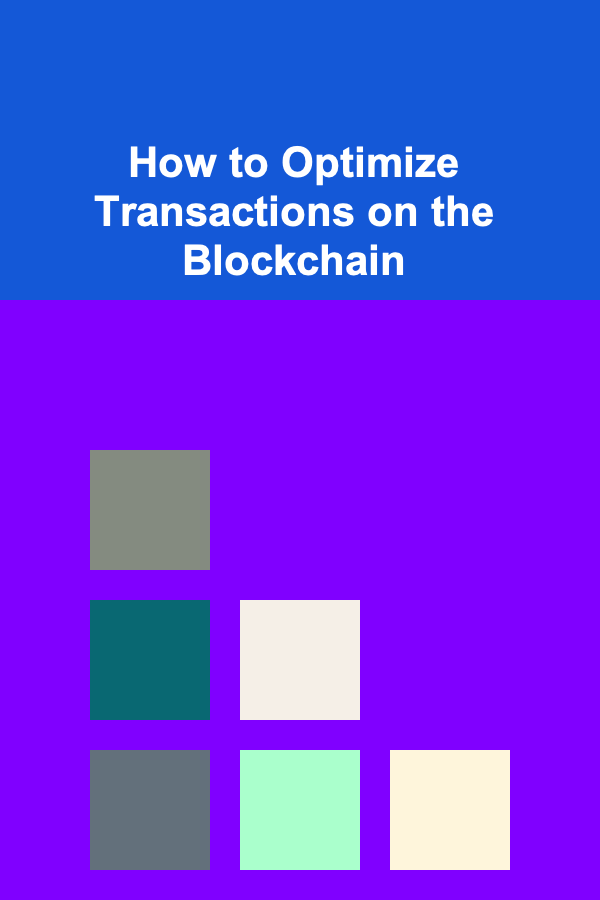
How to Optimize Transactions on the Blockchain
ebook include PDF & Audio bundle (Micro Guide)
$12.99$11.99
Limited Time Offer! Order within the next:

Blockchain technology has revolutionized the way we approach data security, decentralized systems, and digital currencies. One of the key features of blockchain is its ability to process and record transactions in a secure and transparent manner. However, as blockchain networks grow and evolve, the efficiency of transaction processing becomes increasingly important. Optimizing transactions on the blockchain is critical for improving scalability, reducing costs, and enhancing the overall user experience. This article will explore various methods, technologies, and strategies for optimizing blockchain transactions, from improving transaction speed and throughput to reducing fees and enhancing security.
Understanding Blockchain Transaction Mechanisms
Before diving into optimization strategies, it's essential to understand how blockchain transactions work. A blockchain transaction typically involves transferring ownership of a digital asset (such as cryptocurrency) between parties. The transaction is verified and added to a distributed ledger by a consensus mechanism, which ensures that all participants agree on the state of the ledger.
The main components of a blockchain transaction include:
- Transaction Data: Information such as the sender, recipient, amount, and timestamp.
- Cryptographic Signatures: Digital signatures are used to verify the authenticity of the transaction.
- Smart Contracts: Self-executing contracts with the terms of the agreement written into code, used in platforms like Ethereum.
- Consensus Mechanism: A protocol that ensures agreement among network participants, such as Proof of Work (PoW), Proof of Stake (PoS), or others.
The efficiency of these transactions is determined by various factors, including block size, block time, consensus algorithms, and network latency. Optimizing blockchain transactions is about addressing the bottlenecks in these components.
Challenges in Blockchain Transaction Optimization
1. Scalability Issues
One of the most significant challenges for blockchain networks is scalability. As the number of transactions increases, it can overwhelm the network, resulting in slower processing times and higher transaction fees. Public blockchains like Bitcoin and Ethereum face issues related to the limited number of transactions that can be processed per second (TPS). For instance, Bitcoin can handle around 3-7 TPS, while Ethereum can process around 30 TPS. This limitation is a significant bottleneck in the widespread adoption of blockchain technology for applications requiring high throughput.
2. High Transaction Fees
As blockchain networks become congested, transaction fees tend to increase. This happens because users are competing to have their transactions included in the next block, so they raise their fees to incentivize miners or validators to prioritize their transactions. High fees can make blockchain transactions costly, especially for smaller or micro-transactions.
3. Latency and Delays
Blockchain transactions are not instantaneous. Depending on the network, it can take several minutes or even hours for a transaction to be confirmed. Delays in transaction confirmation can be problematic for use cases such as real-time payments, supply chain tracking, and decentralized finance (DeFi).
4. Security Concerns
While blockchain is generally secure, the optimization of transactions can sometimes introduce new security risks. For instance, faster transaction processing might increase the chances of double-spending attacks or reduce the effectiveness of cryptographic protections if not implemented carefully. Security must always be balanced with performance.
Strategies for Optimizing Blockchain Transactions
1. Layer 2 Solutions
Layer 2 solutions are technologies that operate on top of an existing blockchain network to improve transaction efficiency. By offloading some of the work from the main blockchain (Layer 1), these solutions can significantly increase transaction speed, reduce costs, and alleviate congestion.
Examples of Layer 2 Solutions:
- The Lightning Network: Used primarily for Bitcoin, the Lightning Network allows for fast, off-chain transactions. By creating payment channels between users, it enables near-instantaneous and low-cost transactions while only occasionally settling on the main blockchain.
- Plasma: A framework for building scalable decentralized applications (dApps) on Ethereum. Plasma allows for the creation of child chains that can process transactions off-chain and periodically submit the results to the main Ethereum blockchain.
- Rollups: Rollups are a type of Layer 2 scaling solution that aggregates multiple transactions into a single one, reducing the load on the main chain. Optimistic rollups and zk-rollups are two common types, offering varying benefits in terms of speed and security.
These Layer 2 solutions allow blockchain networks to process more transactions in less time while maintaining the security and decentralization of the underlying network.
2. Sharding
Sharding is a technique that divides a blockchain network into smaller partitions, called "shards," each of which processes its transactions. By breaking the blockchain into multiple parts, each shard can process transactions in parallel, significantly improving throughput.
For example, Ethereum 2.0 plans to implement sharding as part of its upgrade from a Proof of Work (PoW) to a Proof of Stake (PoS) consensus mechanism. Sharding will enable the network to scale by allowing multiple chains to operate simultaneously, each processing its transactions independently of the others.
3. Transaction Compression
Transaction compression involves reducing the amount of data that needs to be processed in each transaction. By compressing transaction data, the blockchain can handle more transactions within each block, effectively increasing the throughput.
One method of transaction compression is using Merkle Trees, which allow large sets of data to be represented with a single hash. This makes it easier to verify and compress transactions, reducing the data footprint and improving the speed of transaction verification.
4. Optimizing Consensus Mechanisms
The choice of consensus mechanism plays a vital role in the speed and efficiency of blockchain transactions. The traditional Proof of Work (PoW) consensus mechanism, used by Bitcoin, requires miners to solve complex mathematical problems, leading to high energy consumption and slower transaction times. Alternative consensus mechanisms can help improve transaction efficiency.
- Proof of Stake (PoS): In PoS, validators are selected based on the amount of cryptocurrency they hold and are willing to "stake" as collateral. PoS reduces the need for energy-intensive computations and speeds up transaction processing.
- Delegated Proof of Stake (DPoS): A variation of PoS, DPoS delegates the responsibility of validating transactions to a smaller set of trusted validators, further increasing transaction speed and reducing fees.
- Proof of Authority (PoA): In PoA, only pre-approved validators can create new blocks. This reduces the time it takes to reach consensus and improves transaction throughput, making it suitable for private or permissioned blockchains.
Choosing the right consensus mechanism is crucial for optimizing the balance between security, decentralization, and transaction speed.
5. Transaction Pool Management
Transaction pools, or mempools, are where unconfirmed transactions are stored before they are added to a block. Optimizing the management of transactions in the pool can help reduce delays and ensure that transactions with higher fees are prioritized.
- Dynamic Fee Adjustment: Some blockchain networks adjust transaction fees based on network congestion. By dynamically adjusting fees, users can ensure that their transactions are processed in a timely manner without overpaying during periods of low congestion.
- Transaction Prioritization: Implementing algorithms that prioritize transactions based on factors like fee, size, and age can help ensure that the most critical transactions are processed first, improving overall efficiency.
6. Optimized Block Structures
Another way to optimize blockchain transactions is through the use of optimized block structures. The size and structure of blocks can impact the speed and cost of transactions. For example, increasing the block size can allow more transactions to be included in each block, thus reducing the per-transaction cost. However, larger blocks can also lead to network centralization, as more powerful nodes are needed to process them.
Innovative approaches like Compact Blocks and Segregated Witness (SegWit) have been introduced to optimize block size and structure. SegWit, used by Bitcoin and other networks, separates signature data from transaction data, allowing more transactions to fit into each block.
7. Decentralized Autonomous Organizations (DAOs)
DAOs are self-governing entities that operate on blockchain networks, and they can play a role in optimizing transaction processes. By creating decentralized decision-making frameworks, DAOs can streamline the process of upgrading blockchain protocols and implementing transaction optimization strategies.
DAOs can automate certain aspects of transaction validation and dispute resolution, ensuring that the blockchain network operates more efficiently. Moreover, the decentralized nature of DAOs means that decisions are made collaboratively, leading to more transparent and community-driven optimizations.
Conclusion
Optimizing blockchain transactions is a complex but necessary endeavor to ensure the scalability, efficiency, and security of blockchain networks. From Layer 2 solutions like the Lightning Network to sharding, transaction compression, and optimized consensus mechanisms, various strategies exist to enhance blockchain performance.
As blockchain technology continues to mature, ongoing research and development will likely lead to even more effective optimization techniques. The key to successful blockchain optimization lies in balancing speed, cost, and security while maintaining decentralization and trust in the system. By adopting these strategies and embracing innovation, blockchain networks can handle the growing demands of the digital economy, paving the way for more widespread adoption and practical applications in industries ranging from finance to supply chain management.
Reading More From Our Other Websites
- [Ziplining Tip 101] 🌟 Best Off‑Season Zipline Deals and Discounts for Budget Travelers
- [Organization Tip 101] Top Benefits of Upgrading to a Smart Home Security Camera System
- [Home Soundproofing 101] How to Soundproof a Loft or Attic Space
- [Gardening 101] Native vs. Exotic: Choosing the Best Plants to Attract Butterflies
- [Home Rental Property 101] How to Sublet Your Rental Property Legally and Safely
- [Home Party Planning 101] How to Set Up a Stylish Home Bar for Your Party
- [Personal Finance Management 101] Best Techniques for Saving Money and Avoiding Financial Debt
- [Organization Tip 101] How to Use Technology for Smart Home Organization
- [Home Party Planning 101] How to Set Up a DIY Snack Bar for Your Next Home Party
- [Home Budget Decorating 101] How to Use Wall Art to Elevate Your Home on a Budget

How to Prevent Noise Pollution in a Busy Neighborhood
Read More
How To Understand the Stoic Path to Freedom
Read More
How To Interpret the Symbolism in Norse Myths
Read More
How to Bake Perfect Cupcakes Every Time
Read More
10 Tips for Understanding Your Lease Agreement
Read More
How to Make Seed Bead Earrings: A Step-by-Step Guide for Beginners
Read MoreOther Products

How to Prevent Noise Pollution in a Busy Neighborhood
Read More
How To Understand the Stoic Path to Freedom
Read More
How To Interpret the Symbolism in Norse Myths
Read More
How to Bake Perfect Cupcakes Every Time
Read More
10 Tips for Understanding Your Lease Agreement
Read More